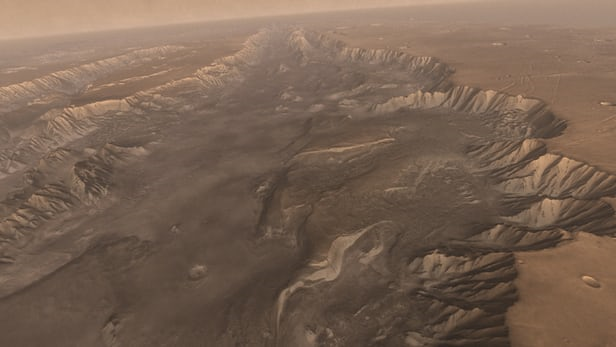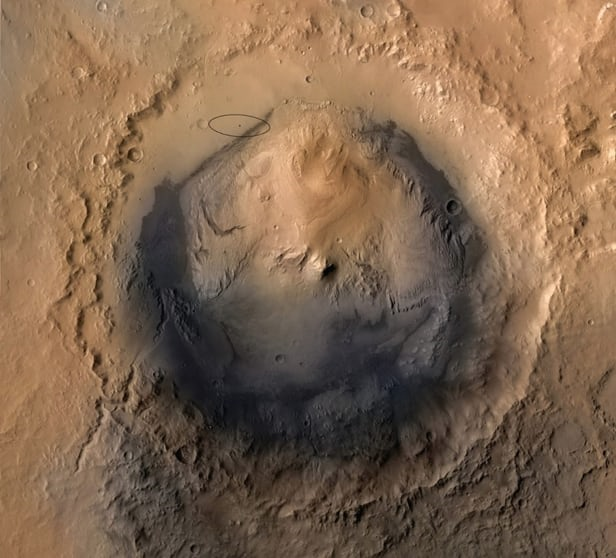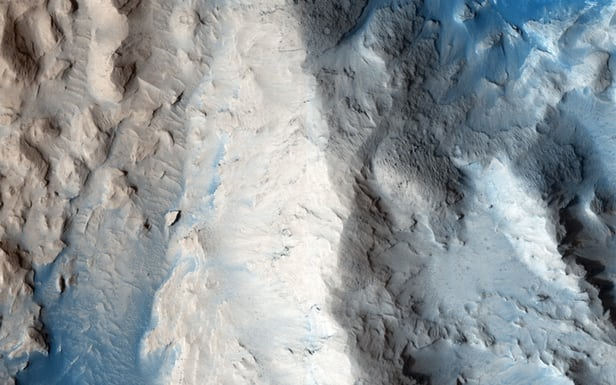October 10, 2016
Three great places to live on Mars. Assuming that SpaceX can refuel an orbiting spacecraft, build boosters capable of launching 1,000 times over, establish a propellant factory on another planet and of course, that you've got US$100,000 to spare, you could soon be faced with some pretty tough life choices. Earlier this week Elon Musk outlined his plan to send one million people off to colonize Mars, but there is a lot to consider when sizing up your own little patch of rock and dust. To get a handle on some of the likely settlement sites if Musk's interplanetary plans do materialize, New Atlas checked in with who we'll call realtors of the Red Planet to find out some prime locations to set up shop.
The fact of the matter is that there are tens, if not hundreds of potential Mars landing sites being bandied about by scientists concerned with such endeavors. At a NASA workshop last October, hundreds of researchers from around the world debated the strengths and weaknesses of 48 strong candidates, and the reality is these will be chopped and changed as we come to learn more about our dusty red neighbor. But hey, it's been a big week for Mars and the romantic notion of dreaming big, so we'll get into the spirit of things and let our imaginations run wild just a little.
What we know is that the landing sites should have plenty of potential for discovery, allowing explorers to hunt for signs of life and answer key questions about Mars without needing to travel far. But close proximity to scientific jackpots are no good if our pioneers can't survive, so the safety of the landing site is critical. Dr. Mason Peck, who served as NASA's Chief Technologist from 2011 to 2013 and now as an adviser to the Mars One mission, explains a couple of key considerations.
"A landing site needs ready access to water," Peck tells New Atlas. "That's not too difficult, since NASA has discovered that Mars is pretty wet. Even the driest parts, roughly near the equator, offer some water. But water is essential – not merely for drinking and, eventually crops, but also for radiation shielding. It's also a ready source of oxygen, through the same electrolysis that one might use to produce rocket fuel: H2 and O2. That simplest, most efficient of rocket propellants is safe, powerful, and a natural result of the same infrastructure necessary for other long-term needs."
The radiation Peck speaks of is another ominous shadow looming over our prospects of survival on the Red Planet. Here, within the confines of Earth's magnetic field and relatively thick atmosphere, we are safe from harmful radiation particles sent hurtling through space by galactic cosmic rays and solar flares, not to mention the constant stream of protons ejected by the sun. But Mars has no magnetic field to speak of and a much thinner atmosphere than we're used to, so although NASA is looking into materials and even artificial forcefields that might offer protection, a carefully selected site could certainly make things easier.
"A landing site probably should be near some natural formation that makes it easier to use regolith (the Mars soil) to provide radiation shielding for a long-term habitat: tunnel into soft regolith and shore it up like a mineshaft, move the regolith on top of a habitat to bury it, or some combination," explains Peck. "Sand or fine-grain material might be easiest. Certain lava tubes may also be suitable. This idea for radiation shielding is not new, but now that we are learning more about the surface geology, we can use that information to select landing sites that enable the astronauts, or colonists, to construct this sort of habitat. And it may be a lot more mass-efficient – so, cheaper – to use material from Mars than to bring everything from Earth."
Brian Enke is a senior research analyst at the Southwest Research Institute's Department of Space Studies and author of the 2005 sci-fi novel Shadows of Medusa, which tracks the exploits of human settlers in Mars' Medusae Fossae region. He tells us that it is important to note which areas should be avoided when selecting a landing site, a list that includes polar regions, volcano tops, extremely dusty basins and small craters with less than a 100 km (62 mi) radius.
"Why? Polar regions are very cold in the winter and very windy during other seasons," he explains. "Volcano tops offer very little atmosphere to protect settlers from radiation. Too much dust is harder to filter out of machines and people. Small craters are more hazardous and they restrict your exploration abilities."
The good news is that Mars has as much land area as our own Earth, so despite these no-go zones we're still left with plenty of room to do our thing. This means potentially a plethora of places where we could make our first footprints, but here are three that Enke tells us look very promising right now.
The depths of Valles Marineris
 Known as the Grand Canyon of Mars, this deep gulf stretches 4,000 km (2,485 mi) along the Martian Equator and is 8 km (5 mi) deep in some places. On one hand, landing a spacecraft among the steep slopes, jagged gullies and potentially fierce canyon winds would be a mighty feat, but it may well be worth the risk.
Known as the Grand Canyon of Mars, this deep gulf stretches 4,000 km (2,485 mi) along the Martian Equator and is 8 km (5 mi) deep in some places. On one hand, landing a spacecraft among the steep slopes, jagged gullies and potentially fierce canyon winds would be a mighty feat, but it may well be worth the risk.
Temperatures in the daytime can get close to a balmy 32° F (0° C) and it is believed that there may be spring-like deposits running beneath the deep canyon, where groundwater could burst through onto the surface. This makes it not only a good candidate for sourcing water, but an ideal hunting ground to search for microbial life. Its low altitude makes for a denser atmosphere, which means better radiation shielding, and it's probably pretty easy on the eye, too.
"Exploring the bottom of Valles Marineris would be the adventure of a lifetime," says Peck. "At those sheltered depths, what sort of geology, climate, or other fascinating discoveries are waiting to be made?"
 Gale Crater
Gale Crater
Sometimes it's better to stick with what you know. Sure, there's a lot we're yet to learn about Mars, but when it comes to sending humans to its surface some travel advice is better than none. In the few short years since NASA's Curiosity rover touched down inside this 154 km (96 mi) wide basin, it has found evidence of water and an ancient freshwater lake, analyzed valuable samples of soil, sent back weather reports and snapped spectacular selfies along the way. So if we do decide to make the Gale Crater our first Martian home, the fact that we've already got some idea of what to expect makes it as good a choice as any.
The mysterious Medusae Fossae Formation
Sitting between the highlands and lowlands near Mars' equator lies a roughly 1,000 km (621 mi) long clump of ... we're not exactly sure. A thick layer of dust conceals the Medusae Fossae Formation from the view of orbiting spectrometers, meaning that we have no concrete evidence of what exactly is lying beneath.
But because of linear ridges that align with winds ripping across the surface, we know that it is soft and easily eroded. This has led scientists to guess that it is a massive deposit of wind-blown dust or volcanic ash. Whatever that material turns out to be, it would probably come in handy for newly immigrated species in need of shelter, says Enke, with the site most likely offering an "abundance of building materials."
 Spoilt for choice
Spoilt for choice
Enke points out that these sites aren't overly unique, and the list of potential suitors is much, much longer. And given how much our knowledge of Mars has improved in recent times, it's likely that in the coming years research will uncover even more locations that could be the first to welcome human settlers. And if those settlers are equipped with the right tools, who knows what the possibilities might be?
"Within the past five years, our perspective has changed 180 degrees," he says. "We now see Mars as a planet rich in resources nearly everywhere we look, at least on a global scale (since we're looking at it from orbit). On a local scale, the outlook gets even better. We can rely on that great cosmic mixing-and-melting machine called 'asteroid impacts' to spread resources ubiquitously about the surface. Give our future settlers some mobility, and they should be able to find any resource they need."